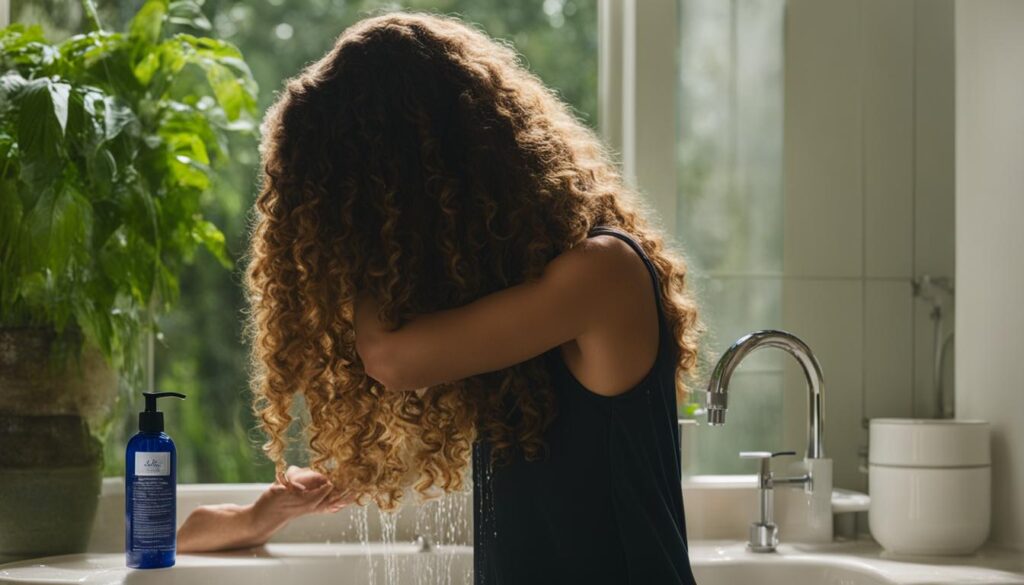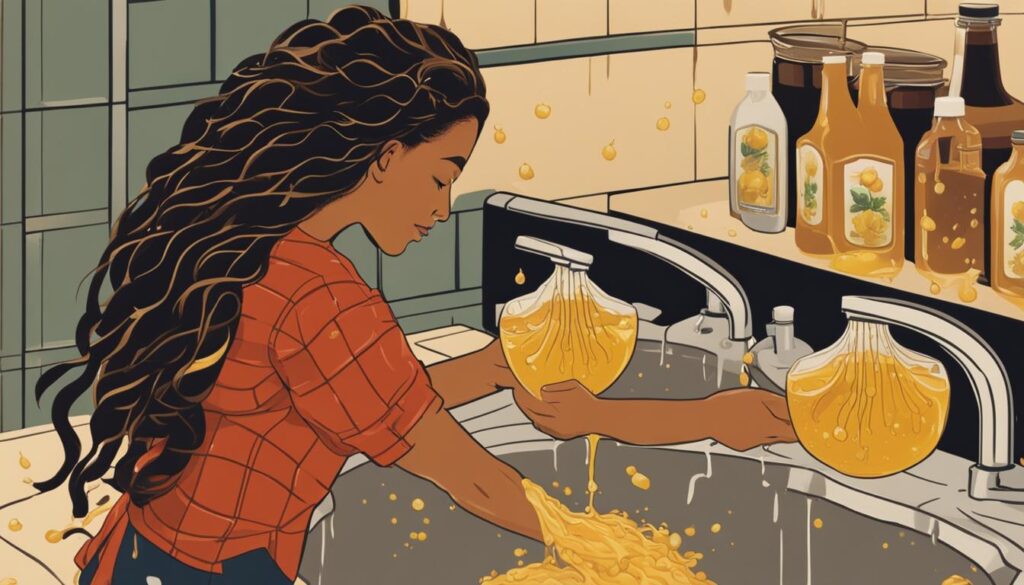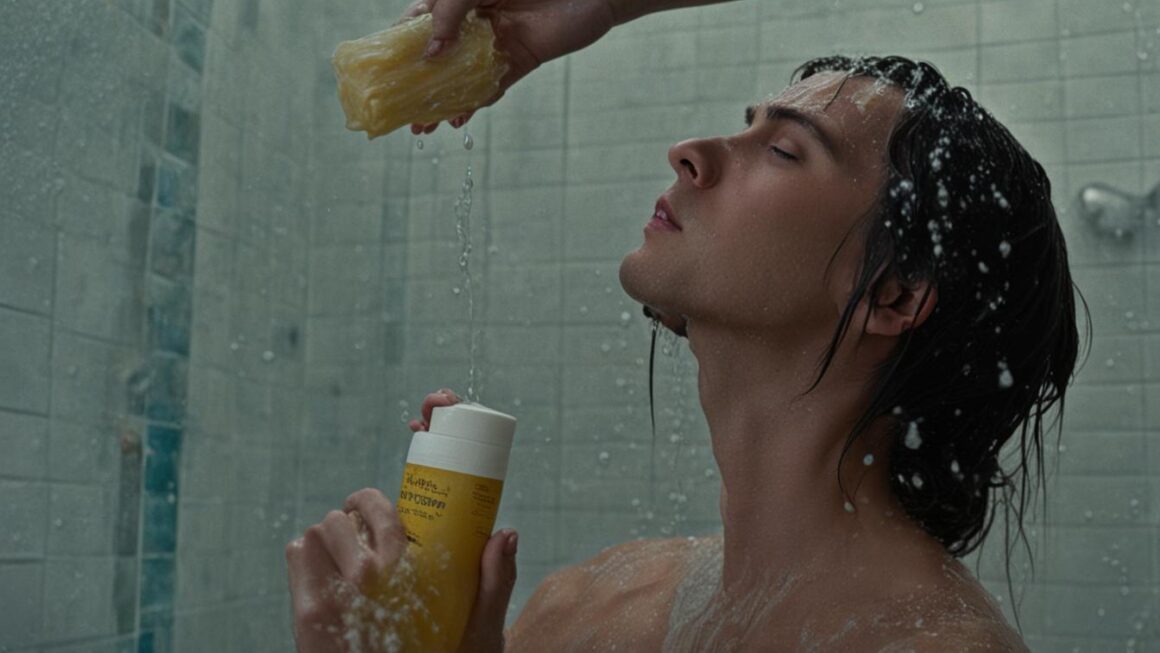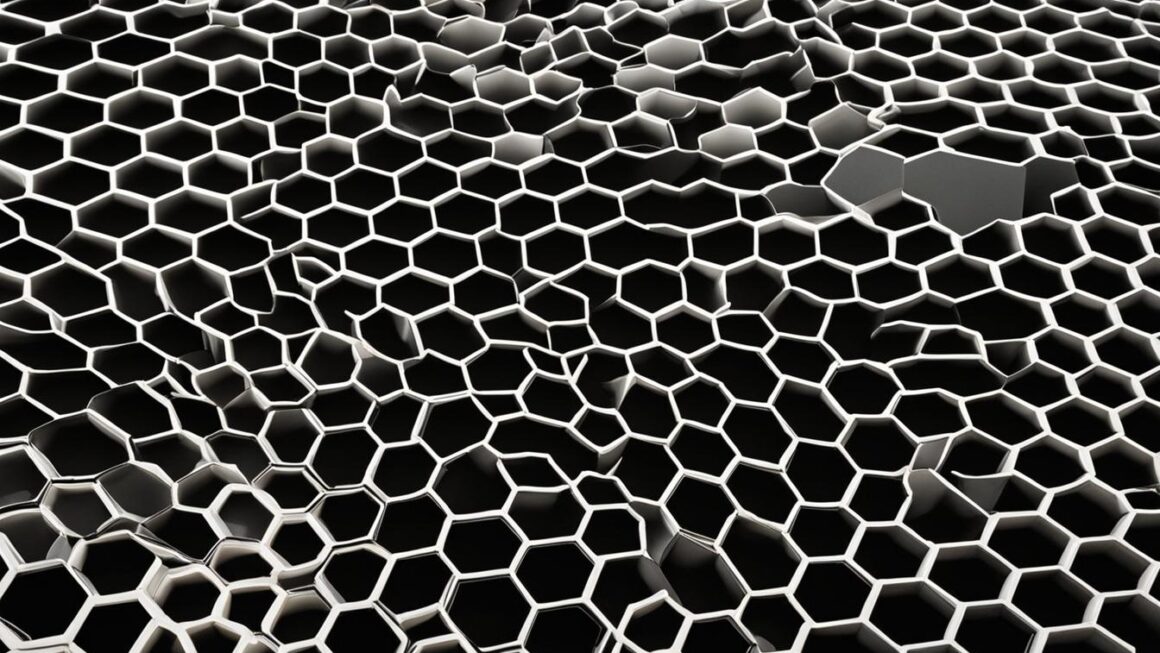Beeswax is a natural wax produced by honey bees and is commonly used in hair products such as gels and pomades. However, excessive buildup of beeswax can leave hair feeling heavy and gunky. To safely remove beeswax from hair, there are several effective methods you can try.
Key Takeaways:
- Using a clarifying shampoo can help cleanse and remove beeswax buildup.
- Co-washing with conditioner can break down beeswax and remove it from the hair.
- Gentle cleansers without harsh sulfates and lather can effectively remove beeswax.
- An apple cider vinegar rinse can strip beeswax from hair and balance pH levels.
- Dishwashing soap can be used as a DIY method to remove heavy beeswax buildup.
Cleanse Your Hair with a Clarifying Shampoo
One of the best ways to remove beeswax buildup from hair is to cleanse it with a clarifying shampoo. This type of shampoo is specifically designed to deeply cleanse the hair and remove product buildup, including beeswax. Look for a clarifying shampoo that is also moisturizing, as it will help prevent the hair from becoming dry and brittle.
When using a clarifying shampoo, it’s important to thoroughly wet your hair and apply the shampoo evenly, focusing on the areas where the beeswax buildup is most concentrated. Massage the shampoo into the scalp and hair for a few minutes to ensure that it effectively breaks down the beeswax. Rinse thoroughly with warm water.
Here’s a table comparing some popular clarifying shampoos:
| Product Name | Key Features |
|---|---|
| CURLS Pure Curls Clarifying Shampoo | Gently removes buildup without stripping moisture |
| Inahsi Soothing Mint Sulfate Free Gentle Cleansing Shampoo | Refreshes and cleanses the scalp while moisturizing the hair |
By using a clarifying shampoo, you can effectively deep cleanse your hair and remove beeswax buildup, leaving your hair feeling clean and refreshed.
Why Use a Clarifying Shampoo?
A clarifying shampoo is formulated to remove stubborn buildup from the hair, including wax, oils, and other product residues. While regular shampoos may not be strong enough to completely cleanse the hair of beeswax, a clarifying shampoo offers a more intensive clean.
Additionally, a clarifying shampoo can help to restore the natural balance of the hair and scalp, as it removes excess oils and buildup. This can result in healthier, more manageable hair.
However, it’s important to note that clarifying shampoos can be drying, so it’s recommended to follow up with a moisturizing conditioner or deep conditioning treatment to keep the hair hydrated.
Co-Wash Your Hair to Remove Beeswax Buildup
Co-washing is an effective method for removing beeswax buildup from your hair. Instead of using traditional shampoo, which can be harsh and strip the hair of its natural oils, co-washing involves using conditioner or a conditioner-like product to cleanse the hair. Co-washing can help break down the beeswax and remove it from the hair, while also providing moisture and nourishment.
Depending on your hair type and moisture needs, you can co-wash your hair 1-2 times a week using your favorite conditioner. When co-washing, make sure to thoroughly massage the conditioner into your scalp and hair, paying extra attention to areas with heavy beeswax buildup. Rinse the hair thoroughly to ensure all the beeswax and conditioner are removed.

One highly recommended conditioner for co-washing is the Creme of Nature Creamy Hydration Co-Wash. This product is specifically formulated to provide deep hydration and gently cleanse the hair without stripping away its natural oils. It can effectively remove beeswax buildup while leaving your hair soft, smooth, and manageable.
Co-washing is a great option for those who prefer to avoid harsh shampoos or have dry, damaged hair. It is a gentle yet effective method for removing beeswax buildup and maintaining healthy, beautiful locks. Remember to adjust the frequency of co-washing based on your hair’s specific needs and consult with a professional hairstylist if you have any concerns or questions.
Try a Gentle Cleanser for Beeswax Removal
When it comes to removing beeswax buildup from your hair, using a gentle cleanser can be a great option. These cleansers are specifically designed to remove impurities from your hair without stripping it of its natural oils.
A low-poo cleanser is an excellent choice for natural hair wax removal. It contains fewer sulfates and lathers less than traditional shampoos, making it a gentler option for your hair. These cleansers effectively break down and remove beeswax buildup, leaving your hair clean and free from residue.
Here is a comparison table of popular low-poo cleansers for beeswax removal:
| Cleanser | Description | Price |
|---|---|---|
| SheaMoisture Coconut & Hibiscus Curl & Shine Shampoo | This low-poo cleanser is formulated with natural ingredients to cleanse and hydrate the hair, leaving it soft and manageable. | $9.99 |
| DevaCurl No-Poo Original Zero Lather Conditioning Cleanser | This no-poo cleanser is perfect for removing beeswax buildup without stripping the hair. It leaves the hair moisturized and defined. | $22.00 |
| As I Am Coconut CoWash Cleansing Conditioner | This co-wash cleanser gently removes beeswax and impurities from the hair while promoting moisture retention and shine. | $8.99 |
Choose a cleanser that suits your hair type and preferences. Follow the instructions on the product’s packaging for best results. Remember to always condition your hair after using a cleanser to restore moisture and maintain its health.
Benefits of Using a Gentle Cleanser for Beeswax Removal
- Removes beeswax buildup without stripping the hair
- Gently cleanses the hair and scalp
- Promotes moisture retention
- Leaves the hair soft, manageable, and free from residue
Use Apple Cider Vinegar to Strip Beeswax from Hair
Apple cider vinegar (ACV) is known for its clarifying properties and can help strip beeswax from hair. ACV can be used as a natural rinse to remove beeswax buildup and restore the pH balance of the hair. To create an ACV rinse, mix equal parts ACV and water in a bowl or spray bottle.

After shampooing and conditioning your hair, apply the ACV rinse to your hair and scalp. Massage it in gently, making sure to distribute it evenly. Let the rinse sit for a few minutes to allow the ACV to break down the beeswax. Then, rinse your hair thoroughly with cool water to remove the ACV and any remaining beeswax.
Benefits of Using Apple Cider Vinegar for Beeswax Removal
- ACV helps to dissolve beeswax and other product buildup, leaving your hair clean and fresh.
- It can restore the natural pH balance of your hair and scalp, promoting healthy hair growth.
- ACV can help soothe an itchy scalp and alleviate dandruff caused by beeswax buildup.
Using apple cider vinegar as a hair rinse is a natural and effective way to remove beeswax buildup and restore the health of your hair. It’s a gentle alternative to harsh clarifying shampoos and can be used regularly without stripping the hair of its natural oils. Plus, the added benefits of a balanced pH and a soothed scalp make ACV an excellent choice for beeswax removal.
Incorporating an ACV rinse into your hair care routine can help you maintain clean, beeswax-free hair. Remember to dilute the ACV with water before using it to avoid any potential scalp irritation, and always follow up with a moisturizing conditioner to keep your hair hydrated and nourished.
| Method | Benefits |
|---|---|
| ACV Rinse | Removes beeswax buildup, restores pH balance, soothes scalp |
| Clarifying Shampoo | Deeply cleanses hair, removes excess beeswax |
| Co-Washing | Conditions and cleanses hair, breaks down beeswax |
| Gentle Cleanser | Removes beeswax without harsh chemicals, maintains hair’s natural oils |
Remove Beeswax with Dishwashing Soap
Dishwashing soap can be an effective way to remove heavy beeswax buildup from hair. Shampooing with dish soap can help break down the wax and add body to the hair. After shampooing with dish soap, follow up with your regular conditioner and leave it on for an extra 5-10 minutes to restore moisture to the hair. Keep in mind that this method may not be suitable for all hair types, so it’s best to test it on a small section of your hair before proceeding.
Using dishwashing soap as a DIY hair wax removal method can be convenient and cost-effective. The soap’s degreasing properties help to dissolve the beeswax, making it easier to wash out. However, it’s important to note that dish soap can strip the hair of its natural oils, so it’s crucial to follow up with a conditioner to maintain moisture balance.
Using dish soap to remove beeswax from hair can be quite effective. The soap’s strong surfactants help to break down the beeswax and make it easier to rinse out. However, it’s essential to be cautious and avoid using dish soap too frequently, as it can be drying to the hair. Make sure to condition your hair thoroughly after using dish soap to restore moisture and prevent damage.
When using dishwashing soap for beeswax removal, it’s recommended to apply a small amount of dish soap directly to wet hair and massage it gently into the scalp and strands. Rinse thoroughly with warm water and follow up with a conditioner to restore moisture and prevent dryness. Remember to test the dish soap method on a small section of hair before applying it to the entire head to ensure compatibility with your hair type.
| Pros | Cons |
|---|---|
| Effective in removing heavy beeswax buildup | Can be drying to the hair if not followed by conditioner |
| Cost-effective alternative to specialized products | May not be suitable for all hair types |
| Easy to find in most households | Can strip the hair of natural oils |
Natural Oil Method for Beeswax Removal
If you’re looking for a natural and gentle method to remove beeswax buildup from your hair, the natural oil method is worth considering. With just a few simple steps, you can effectively eliminate beeswax and restore the health of your locks.
How to use the natural oil method:
- Start by choosing a natural oil such as olive oil, coconut oil, or jojoba oil. These oils have moisturizing properties and can effectively break down beeswax.
- Apply a generous amount of the chosen oil to the areas with beeswax buildup. Massage the oil into the hair, ensuring it reaches the roots.
- Allow the oil to sit in your hair for about 30 minutes to soften the beeswax. You can cover your hair with a shower cap to enhance the process.
- Gently comb through your hair to loosen the softened beeswax. You may notice the wax starting to crumble and come off easily.
- Once you’ve removed as much beeswax as possible, it’s time to thoroughly wash your hair. Use a clarifying shampoo to cleanse away any remaining residue.
- Finish off with a deep conditioner to restore moisture and nourishment to your hair.
The natural oil method is a gentle approach to removing beeswax buildup, making it suitable for all hair types. However, it’s always a good idea to do a patch test before applying the oil to your entire head of hair, especially if you have sensitive skin or any known allergies.
By using natural oils to remove beeswax, you can effectively eliminate buildup and restore the health and vibrancy of your hair. Remember to follow up with regular cleansing and conditioning to keep your hair in optimal condition.
Remove Beeswax with a Hairdryer
If you’re looking for an effective method to remove beeswax from your hair, using a hairdryer can be a great option. This method allows you to melt and crumble the wax, making it easier to remove from your hair strands. However, it’s important to exercise caution and follow the right steps to ensure the safety of your hair.
To remove beeswax with a hairdryer, start by wrapping the hair sections with beeswax in paper towels. Make sure the beeswax is completely covered by the paper towels to protect your hair from direct heat exposure. Then, set your hairdryer to high heat and begin heating the wrapped sections. As the wax starts to melt and crumble, gently press it down and pull it out of your hair.
It’s important to keep the hairdryer at least 6 inches away from your hair to avoid burning or damaging your hair. Additionally, be careful when handling the melted wax to avoid any accidents or burns. Once you have removed the beeswax, you can follow up with your regular hair care routine to restore moisture and nourishment to your hair.
Important Note:
Before using a hairdryer to remove beeswax, it’s essential to check the compatibility of this method with your hair type. Some hair types, such as fine or damaged hair, may be more susceptible to heat damage. If you have concerns about using a hairdryer, it’s recommended to consult with a professional stylist or try alternative methods mentioned in this article.
Using a hairdryer to remove beeswax from your hair can be an effective method for deep cleansing and wax removal. However, it’s crucial to proceed with caution and ensure the safety of your hair. By following the steps mentioned above and considering the compatibility of this method with your hair type, you can successfully remove beeswax buildup and maintain healthy, wax-free locks.
Conclusion
Removing beeswax from hair can be a challenging task, but with the right methods and products, it can be done effectively. Whether you choose to cleanse your hair with clarifying shampoo, co-wash, use gentle cleansers, try an ACV rinse, use dishwashing soap, apply natural oils, or use a hairdryer, there are several DIY hair wax removal options available.
By following these techniques, you can safely remove beeswax buildup from your hair and maintain healthy, wax-free locks. Experiment with different methods to find the one that works best for you and remember to always treat your hair with care throughout the process.
Keep in mind that prevention is key when it comes to beeswax buildup. Try to avoid excessive use of beeswax-based hair products and ensure regular cleansing and conditioning to keep your hair healthy and free from buildup.
Best Ways to Remove Beeswax from Hair:
- Cleanse your hair with a clarifying shampoo
- Co-wash your hair to remove beeswax buildup
- Try a gentle cleanser for beeswax removal
- Use apple cider vinegar to strip beeswax from hair
- Remove beeswax with dishwashing soap
- Use natural oils as a method for beeswax removal
- Remove beeswax with a hairdryer
By incorporating these methods into your hair care routine, you can effectively remove beeswax and maintain healthy, wax-free hair. Remember to always listen to your hair’s needs and choose the method that works best for you.
FAQ
How can I remove beeswax from my hair?
There are several effective methods you can try to safely remove beeswax from your hair.
What is a clarifying shampoo, and how can it help remove beeswax buildup?
A clarifying shampoo is specifically designed to deep cleanse the hair and remove product buildup, including beeswax.
Can co-washing help remove beeswax from hair?
Yes, co-washing, which involves using conditioner or conditioner-like products to cleanse the hair, can help break down and remove beeswax buildup.
What are low-poo and no-poo cleansers, and can they effectively remove beeswax?
Low-poo and no-poo cleansers are gentle alternatives to traditional shampoos that can effectively remove beeswax without harsh ingredients.
How does apple cider vinegar (ACV) help strip beeswax from hair?
ACV has clarifying properties that can help balance the pH levels of the hair and remove bacteria associated with beeswax buildup.
Can dishwashing soap be used to remove beeswax from hair?
Yes, dishwashing soap can be an effective method to break down and remove heavy beeswax buildup from hair.
Are natural oils effective in removing beeswax from hair?
Yes, natural oils such as olive oil can be applied to the beeswax to soften and crumble it, making it easier to remove from the hair.
Can a hairdryer help remove beeswax from hair?
Yes, using a hairdryer on high heat can melt and crumble the beeswax, allowing for easier removal. However, caution must be taken to avoid burning or damaging the hair.
What is the best method for removing beeswax from hair?
The best method for removing beeswax from hair may vary depending on individual preferences and hair type. It is recommended to try different methods and find the one that works best for you.




